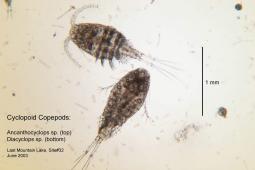
Zooplankton (zoo - = animal; plankton = floating, drifting) comprise a diverse range of aquatic organisms in which many phyla are represented. They are dominated by four major groups that spend some or all of their life cycle in the water column of lakes and rivers. These include: protozoa (four phyla/subphyla and eleven classes: unicellular or colonial heterotrophic eukaryotes); rotifers or “wheel animals” (phylum Rotifera; two classes); and two sub-classes of Crustacea (phylum Arthropoda), the Cladocera and the Copepoda. The size range among freshwater zooplankton typically spans 20 micrometres to a few millimetres. They consume both living and non-living organic matter, some preying on other zooplankton, others on small algae, bacteria and detritus. Large-bodied cladoceran species (e.g., Daphnia) are particularly effective at grazing algae of suitable dimensions, and can be responsible for periodic high water clarity in otherwise turbid lakes. Other groups of animals may be found among the true zooplankton (or holo-plankton) from time to time, whether as life cycle stages, or from temporary benthic entrainment due to water mixing. These may include a few coelenterates (hydras, freshwater jellyfish), various larvae and adults of fish, insects (especially midges of the family Chaoboridae), trematode flatworms, annelid worms, gastrotrichs, ostracodes, water mites, and others.
Zooplankton play a crucial role in ecosystem function by transferring energy from lower to higher trophic levels in aquatic food webs. They are of great importance as food for many fish species, especially juvenile stages. For the crustacean zooplankton, keys and lists have been assembled for some Canadian provinces (notably Ontario, Alberta, and British Columbia), and for North America as a whole. Based on available Canadian province lists (covering both shield and prairie habitats), Saskatchewan should be home to more than fifty species in thirty genera of cladocerans, and more than fifty-four species in thirty-three genera of copepods. However, knowledge of zooplankton biogeography is spotty. The widely distributed or ubiquitous species are those with tolerance to a wide range of physical and chemical conditions. Other genera may be regionally or locally restricted due to narrower tolerance thresholds. Some groups produce desiccation-resistant cysts or have life stages that can remain viable out of water for periods of time, so that some zooplankton can colonize aquatic habitats—even temporary ones—rapidly. Transportation may occur by a variety of mechanisms, ranging from the water itself to aerial transport and hitch-hiking on animals. Water temperature, depth and current, oxygen, salinity, pH, alkalinity, and the types and abundance of algae and zooplankton predators are among the factors influencing the distribution of species. These base conditions vary with the type of rocks, soils, vegetation and drainages found across the landscape. The full range of inland water types can be found in Saskatchewan. On a broad scale, a transition of conditions extends from northern cold-water systems in the boreal Shield to cool and warm-water systems on the southern prairies. This cline of inland water types means that species occurrence and abundance within zooplankton are highly varied. For this reason a substantial zooplankton diversity exists within Saskatchewan. With few specialists working in this field, the presence of species described from similar habitats elsewhere may be slow to be confirmed. In other cases, particularly in the more obscure and globally less-studied fauna like the protozoa, perhaps some new types may yet be described. Also, species exotic to North America introduced among others by shipping ballast discharges and the aquaria industry will no doubt continue to appear, perhaps colonizing Saskatchewan waters in the future.
Ken Scott